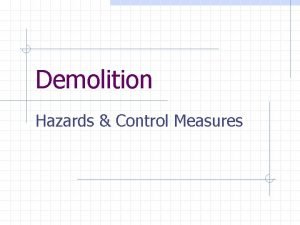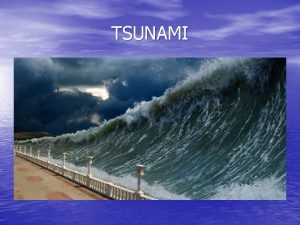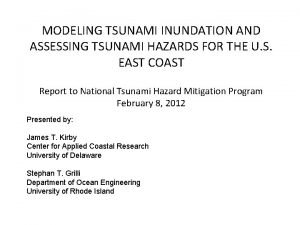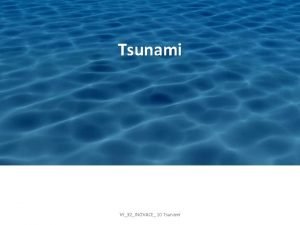Tsunami Hazards Threedimensional Modeling of Tsunami Generation and





- Slides: 5

Tsunami Hazards Three-dimensional Modeling of Tsunami Generation and Near-field Characteristics and Vulnerability of Honolulu Critical Infrastructure to Tsunamis Kwok Fai Cheung Ocean and Resources Engineering University of Hawaii January 30, 2008

Three-dimensional Modeling Hawaii State Civil Defense and National Tsunami Hazard Mitigation Program • Inundation maps based on 100 years of Pacific Rim tsunamis - Development of tsunami evacuation maps with county civil defense - Textbook examples of 2 D nonlinear shallow-water models • Inundation maps for locally generated tsunamis from Big Island - Development of in-house emergency response plans 3 D modeling of Tsunami Generation and Near-field Characteristics • (2+1)D approach with approximate solutions in the vertical direction • Wave dispersion, bore approximation of breaking waves, and energy transfer from seafloor deformation

Vulnerability of Critical Infrastructure to Tsunamis Tsunami Inundation Maps in the Five Pacific Coastal State • Based on historical or paleo-tsunamis or “credible worse-case” scenarios • Not suitable for coastal development planning or vulnerability study FEMA National Flood Insurance Program • $3 Billion FIRM modernization project (tsunami is not considered) • Probabilistic approach to produce 100, 200, and 500 -year flood limits Probabilistic Approach • Mapping of earthquake probability to flood probability through a systematic sampling approach • Calibration with historical runup records (Tentative Results)

Outreach Steering Committee, National Tsunami Hazard Mitigation Program Implementation of the Inverse Algorithm for Tsunami Forecast • NOAA Pacific Marine Environmental Laboratory • Chilean Navy Servicio Hidrográfico y Oceanográfico • National Marine Environmental Forecasting Center of China Community Outreach Presentations in 2007 • State Building Code Committee and Department of Accounting and General Services • State Risk Management Office, UH Office of Risk Management, Aon Risk Services, Inc. , Hawaii • UNESCO ITIC Delegations (4 times) • Department of Land Natural Resources • UH Disaster Management and Humanitarian Assistance Program (simulcast at Bangkok, Tokyo, Okinawa, American Samoa) • Structural Engineer Association of Hawaii Luncheon Advisory • UH Office of the VP for Research, Pac. RBL Project

Publications Yamazaki, Y. , Kowalik, Z. , and Cheung, K. F. Depth-integrated dispersive model for wave breaking and runup. International Journal for Numerical Methods in Fluids, in preparation. Yamazaki, Y. , Wei, Y. , Cheung, K. F. , and Curtis, G. D. (2006). Forecast of tsunamis generated at the Japan-Kuril-Kamchatka source region. Natural Hazards, 38(3), 411 -435 (UNIHI-SEAGRANT-JC-0408). Wei, Y. , Mao, X. Z. , and Cheung, K. F. (2006). Well-balanced finite volume model for long-wave runup. Journal of Waterway, Port, Coastal, and Ocean Engineering, 132(2), 114 -124 (UNIHI-SEAGRANT-JC -05 -03). Wei, Y. , Cheung, K. F. , Curtis, G. D. , and Mc. Creery, C. S. (2003). Inverse algorithm for tsunami forecasts. Journal of Waterway, Port, Coastal, and Ocean Engineering, 129(2), 60 -69 (UNIHI-SEAGRANT-JC 01 -12). Smith, D. A. and Cheung, K. F. (2005). Transport rate of calcareous sand in uni-directional flow. Sedimentology, 52(5), 1009 -1020 (UNIHI-SEAGRANT-JC-03 -06). Smith, D. A. and Cheung, K. F. (2004). Initiation of motion of calcareous sand. Journal of Hydraulic Engineering, 130(5), 467 -472 (UNIHI-SEAGRANT-JC-00 -31). Smith, D. A. and Cheung, K. F. (2003). Settling characteristics of calcareous sand. Journal of Hydraulic Engineering, 129(6), 479 -483 (UNIHI-SEAGRANT-JC-02 -10). Smith, D. A. and Cheung, K. F. (2002). Empirical relationships for grain size parameters of calcareous sand on Oahu, Hawaii. Journal of Coastal Research, 18(1), 82 -93 (UNIHI-SEAGRANT-JC-00 -06). Chandrasekera, C. N. and Cheung, K. F. (2001). Linear refraction-diffraction model for steep bathymetry. Journal of Waterway, Port, Coastal, and Ocean Engineering, 127(3), 161 -170 (UNIHI-SEAGRANT-JC -00 -02). Chandrasekera, C. N. and Cheung, K. F. (1997). Extended linear refraction-diffraction model. Journal of Waterway, Port, Coastal, and Ocean Engineering, 123(5), 280 -286 (UNIHI-SEAGRANT-JC-97 -19).









